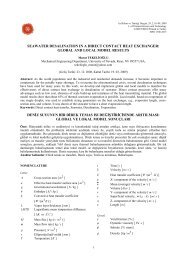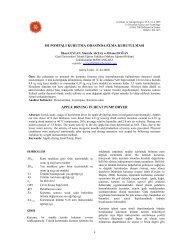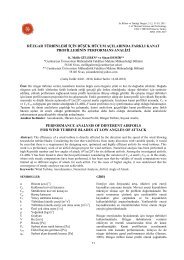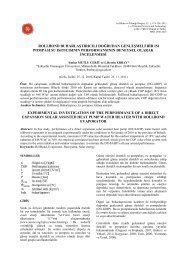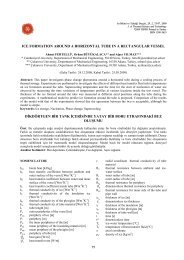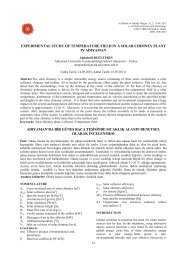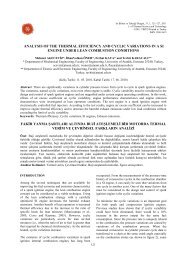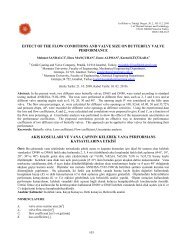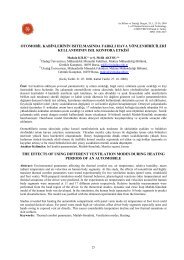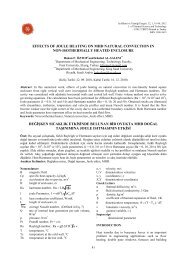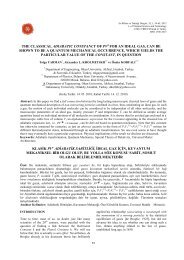modelling of an automotive air conditioning system using anfis
modelling of an automotive air conditioning system using anfis
modelling of an automotive air conditioning system using anfis
Create successful ePaper yourself
Turn your PDF publications into a flip-book with our unique Google optimized e-Paper software.
Predicted E d,tot<br />
(kW)<br />
Predicted W comp<br />
(kW)<br />
Predicted COP<br />
Predicted Q evap<br />
(kW)<br />
Predicted T evap,ao<br />
(K)<br />
specific enthalpies <strong>of</strong> the moist <strong>air</strong> at the inlet <strong>an</strong>d outlet<br />
<strong>of</strong> the evaporator, <strong>an</strong>d enthalpy <strong>of</strong> the condensate<br />
leaving the evaporator, thus having several sources <strong>of</strong><br />
uncertainty. Consequently, the resulting high uncertainty<br />
influences the training process, <strong>an</strong>d causes a poorer<br />
perform<strong>an</strong>ce for the Q evap predictions.<br />
282<br />
280<br />
278<br />
276<br />
274<br />
272<br />
270<br />
r = 0.968<br />
MRE = 0.23%<br />
RMSE = 0.83 K<br />
R 2 = 0.9999<br />
+2%<br />
-2%<br />
270 272 274 276 278 280 282<br />
Experimental T evap,ao<br />
(K)<br />
Figure 2. The ANFIS predictions for the <strong>air</strong> dry bulb<br />
temperature at the evaporator outlet vs. experimental values.<br />
8<br />
7<br />
6<br />
r = 0.970<br />
MRE = 4.48%<br />
RMSE = 0.28 kW<br />
R 2 = 0.9975<br />
+10%<br />
power is also not as good as those for T evap,ao . In fact, the<br />
ANFIS yields even slightly poorer perform<strong>an</strong>ce for<br />
W comp predictions compared with that for Q evap ones, as<br />
reported in Figure 4.<br />
As shown in Figure 5, the ANFIS predictions for the<br />
coefficient <strong>of</strong> perform<strong>an</strong>ce result in a MRE <strong>of</strong> 3.86%, <strong>an</strong> r<br />
value <strong>of</strong> 0.966 <strong>an</strong>d <strong>an</strong> R 2 value <strong>of</strong> 0.9981. Because COP<br />
depends on two parameters, namely the cooling capacity<br />
load <strong>an</strong>d compressor power, it has several uncertainty<br />
sources involved in the evaluation <strong>of</strong> these parameters.<br />
This leads to training <strong>of</strong> the proposed ANFIS <strong>using</strong> data<br />
with high uncertainty, which in turn causes a relatively<br />
poor statistical perform<strong>an</strong>ce for the COP predictions.<br />
Figure 6 shows that the ANFIS predictions for the total<br />
rate <strong>of</strong> exergy destruction in the refrigeration circuit <strong>of</strong> the<br />
<strong>system</strong> have a comparable accuracy with Q evap , W comp<br />
<strong>an</strong>d COP predictions. However, as seen Figure 7, the<br />
ANFIS outst<strong>an</strong>dingly predicts the compressor discharge<br />
temperature with a MRE <strong>of</strong> 0.28%, <strong>an</strong> r value <strong>of</strong> 0.988<br />
<strong>an</strong>d <strong>an</strong> R 2 value <strong>of</strong> 0.9999. The excellent ANFIS<br />
predictions for T dis are due to the high accuracy <strong>of</strong> the<br />
temperature measurements performed in the experiments.<br />
The discharge temperature is <strong>an</strong> indicator <strong>of</strong> the<br />
compressor durability. The possibility <strong>of</strong> the thermal<br />
destruction <strong>of</strong> the compressor oil increases with rising<br />
discharge temperature.<br />
5<br />
4<br />
-10%<br />
3.5<br />
3<br />
r = 0.966<br />
MRE = 3.86%<br />
RMSE = 0.11<br />
R 2 = 0.9981<br />
+10%<br />
3<br />
3 4 5 6 7 8<br />
Experimental Q evap<br />
(kW)<br />
Figure 3. The ANFIS predictions for the cooling capacity vs.<br />
experimental values.<br />
2.5<br />
2<br />
-10%<br />
3,5<br />
3<br />
2,5<br />
r = 0.969<br />
MRE = 5.28%<br />
RMSE = 0.15 kW<br />
R 2 = 0.9957<br />
+10%<br />
1.5<br />
1.5 2 2.5 3 3.5<br />
Experimental COP<br />
Figure 5. The ANFIS predictions for the coefficient <strong>of</strong><br />
perform<strong>an</strong>ce vs. experimental values.<br />
3.5<br />
r = 0.973<br />
2<br />
1,5<br />
-10%<br />
3<br />
2.5<br />
MRE = 4.96%<br />
RMSE = 0.14 kW<br />
R 2 = 0.9962<br />
+10%<br />
1 1.5 2 2.5 3 3.5<br />
Experimental W comp<br />
(kW)<br />
Figure 4. The ANFIS predictions for the compressor power<br />
vs. experimental values.<br />
2<br />
1.5<br />
-10%<br />
Because the evaluation <strong>of</strong> the compressor power<br />
requires the refriger<strong>an</strong>t mass flow rate <strong>an</strong>d enthalpies <strong>of</strong><br />
the refriger<strong>an</strong>t at the evaporator inlet <strong>an</strong>d outlet, the<br />
accuracy <strong>of</strong> the ANFIS predictions for the compressor<br />
1.5 2 2.5 3 3.5<br />
Experimental E d,tot<br />
(kW)<br />
Figure 6. The ANFIS predictions for the total rate <strong>of</strong> exergy<br />
destruction in the refrigeration circuit <strong>of</strong> the refrigeration<br />
<strong>system</strong> vs. experimental values.<br />
133



